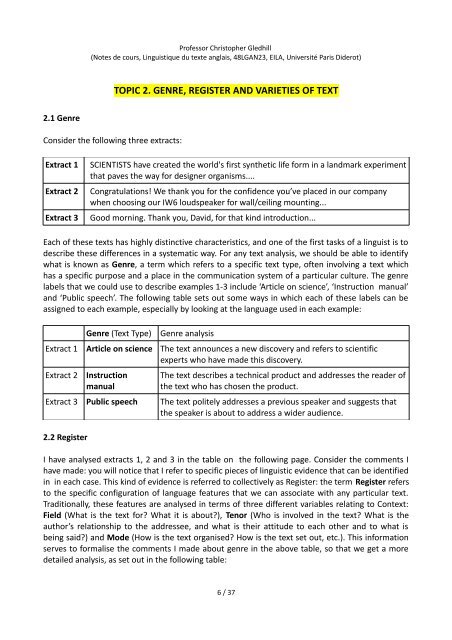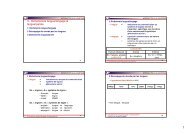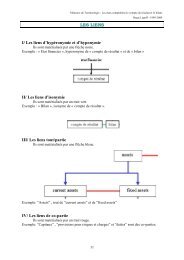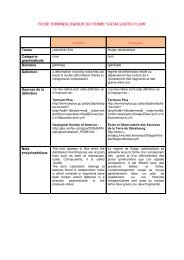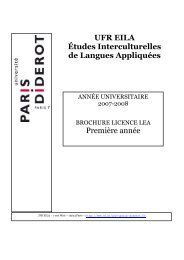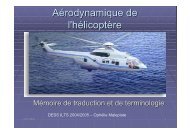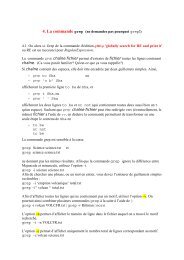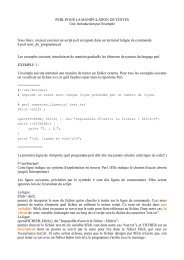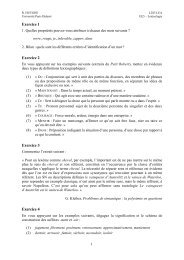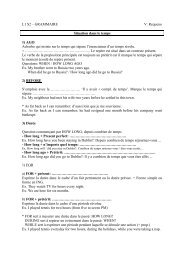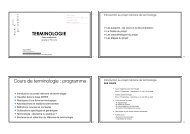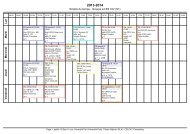INTRODUCTION TO ENGLISH TEXT LINGUISTICS
INTRODUCTION TO ENGLISH TEXT LINGUISTICS
INTRODUCTION TO ENGLISH TEXT LINGUISTICS
You also want an ePaper? Increase the reach of your titles
YUMPU automatically turns print PDFs into web optimized ePapers that Google loves.
Professor Christopher Gledhill<br />
(Notes de cours, Linguistique du texte anglais, 48LGAN23, EILA, Université Paris Diderot)<br />
<strong>TO</strong>PIC 2. GENRE, REGISTER AND VARIETIES OF <strong>TEXT</strong><br />
2.1 Genre<br />
Consider the following three extracts:<br />
Extract 1<br />
Extract 2<br />
Extract 3<br />
SCIENTISTS have created the world's first synthetic life form in a landmark experiment<br />
that paves the way for designer organisms....<br />
Congratulations! We thank you for the confidence you’ve placed in our company<br />
when choosing our IW6 loudspeaker for wall/ceiling mounting...<br />
Good morning. Thank you, David, for that kind introduction...<br />
Each of these texts has highly distinctive characteristics, and one of the first tasks of a linguist is to<br />
describe these differences in a systematic way. For any text analysis, we should be able to identify<br />
what is known as Genre, a term which refers to a specific text type, often involving a text which<br />
has a specific purpose and a place in the communication system of a particular culture. The genre<br />
labels that we could use to describe examples 1-3 include ‘Article on science’, ‘Instruction manual’<br />
and ‘Public speech’. The following table sets out some ways in which each of these labels can be<br />
assigned to each example, especially by looking at the language used in each example:<br />
Genre (Text Type)<br />
Genre analysis<br />
Extract 1 Article on science The text announces a new discovery and refers to scientific<br />
experts who have made this discovery.<br />
Extract 2<br />
Instruction<br />
manual<br />
The text describes a technical product and addresses the reader of<br />
the text who has chosen the product.<br />
Extract 3 Public speech The text politely addresses a previous speaker and suggests that<br />
the speaker is about to address a wider audience.<br />
2.2 Register<br />
I have analysed extracts 1, 2 and 3 in the table on the following page. Consider the comments I<br />
have made: you will notice that I refer to specific pieces of linguistic evidence that can be identified<br />
in in each case. This kind of evidence is referred to collectively as Register: the term Register refers<br />
to the specific configuration of language features that we can associate with any particular text.<br />
Traditionally, these features are analysed in terms of three different variables relating to Context:<br />
Field (What is the text for? What it is about?), Tenor (Who is involved in the text? What is the<br />
author’s relationship to the addressee, and what is their attitude to each other and to what is<br />
being said?) and Mode (How is the text organised? How is the text set out, etc.). This information<br />
serves to formalise the comments I made about genre in the above table, so that we get a more<br />
detailed analysis, as set out in the following table:<br />
6 / 37


